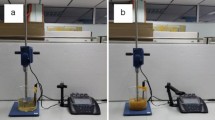Abstract
POTATOES may respond visually in a complex manner to soil acidity1,2, and many of these effects, including those of manganese or aluminium excess, calcium deficiency and potassium deficiency, have been reproduced in sand or water cultures3–7. During an investigation of the interrelationships of iron, potassium and phosphorus in potato plants (var. Majestic) grown in sand culture, characteristic leaf symptoms hitherto seen only in the field under acid-soil conditions were observed. These appeared towards the middle of the season in the upper leaves. Leaflets showed pale yellow-green or whitish intervenal mottling at the base of the lamina in contrast to the apical and marginal regions, which generally remained normal green. Leaflets later became wavy and upcurled at the margin and, in severe cases, the basal region became chlorotic. A plentiful supply of readily available iron, provided either in solution or by increasing the availability of a low iron status with luxury concentrations of potassium8, appeared to be the main factor in producing these symptoms, even at the highest phosphate-level (8-9 milliequivalents/litre). Various combinations of manganese, aluminium, calcium and nitrogen levels tested in previous investigations of soil-acidity factors3–5 did not reproduce the effect described here.
This is a preview of subscription content, access via your institution
Access options
Subscribe to this journal
Receive 51 print issues and online access
$199.00 per year
only $3.90 per issue
Buy this article
- Purchase on Springer Link
- Instant access to full article PDF
Prices may be subject to local taxes which are calculated during checkout
Similar content being viewed by others
References
Wallace, T., Morley Davies, W., Nicholas, D. J. D., and Hewitt, E. J., Long Ashton Ann. Rep. 1946, 61.
Plant, W., Hewitt, E. J., and Nicholas, D. J. D., Long Ashton Ann. Rep. 1947, 97.
Hewitt, E. J., Long Ashton Ann. Rep. 1945, 52.
Hewitt, E. J., Long Ashton Ann. Rep. 1946, 50.
Hewitt, E. J., Long Ashton Ann. Rep. 1947, 82.
Wallace, T., and Hewitt, E. J., Nature, 161, 28 (1948).
Berger, K. C., and Gerloff, G. C., Amer. Potato J., 24, 156 (1947).
Jones, E. W., and Hewitt, E. J., Long Ashton Ann. Rep. 1949, 49.
Wallace, T., “The Diagnosis of Mineral Deficiencies in Plants by Visual Symptoms” (H.M. Stationery Office, 1944).
Quanjer, H. M., Tijd Schrift over Plantenziekten, 32, 97 (1926).
Schwarz, M. Beatrice, Tijd Schrift over Plantenziekten, 32, 321 (1926).
Van Schreven, D. A., Tijd Schrift over Plantenziekten, 40, 226 (1934).
Van der Plank, J. C., “The Potato in Health and Disease” (1936), pp. 235 and 326 by Whitehead, I., McIntosh, T. P., and Findlay, W. M. (1945).
Hewitt, E. J., Report No. 10591, Agric Res. Coun. Mineral Deficiencies Conference (p. 2, 1948).
Author information
Authors and Affiliations
Rights and permissions
About this article
Cite this article
JONES, E. Production in Potato of Leaf Symptoms observed on Plants on Acid Soils together with Associated Tuber Necrosis. Nature 167, 568–569 (1951). https://doi.org/10.1038/167568a0
Issue Date:
DOI: https://doi.org/10.1038/167568a0
Comments
By submitting a comment you agree to abide by our Terms and Community Guidelines. If you find something abusive or that does not comply with our terms or guidelines please flag it as inappropriate.



